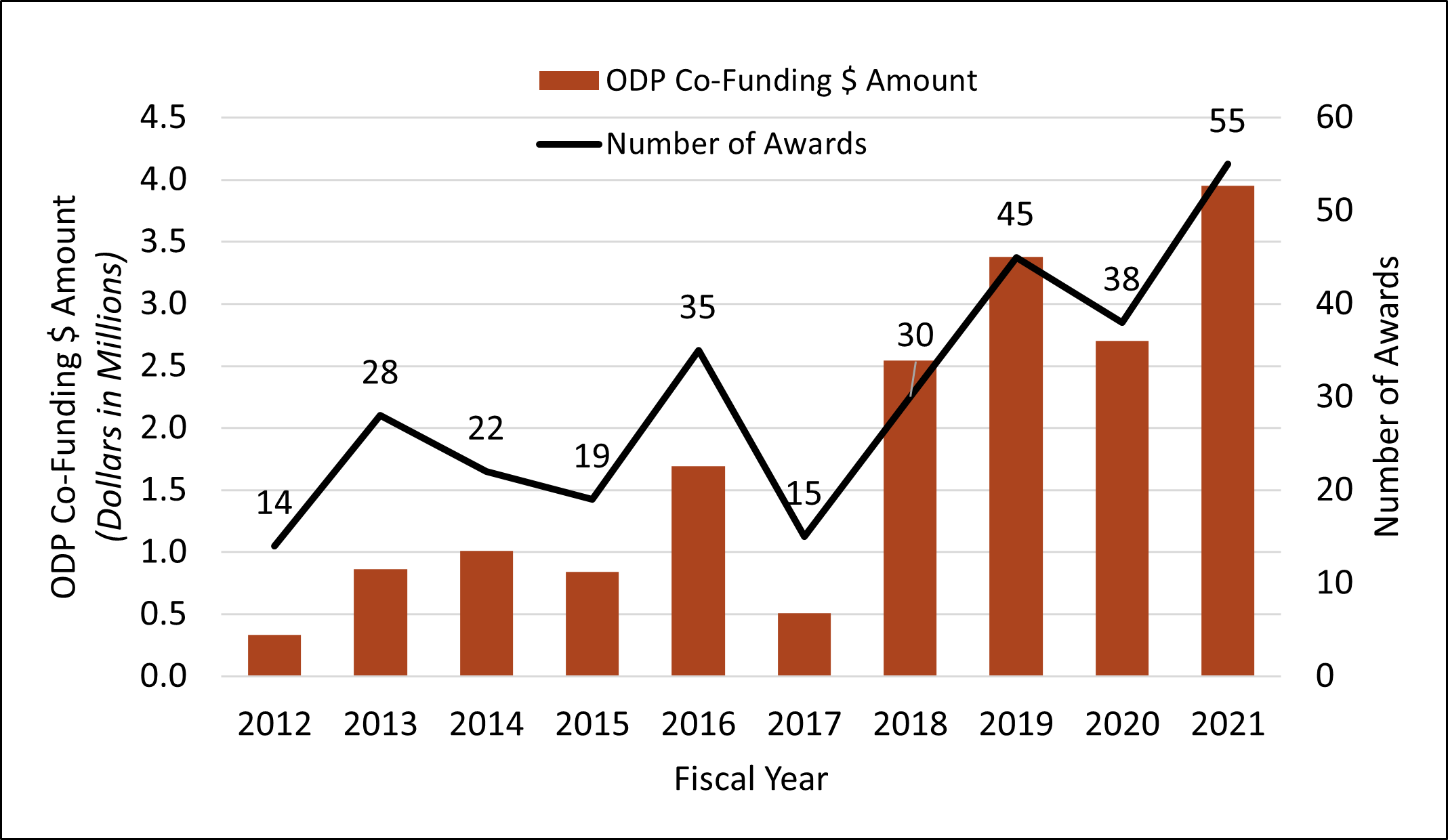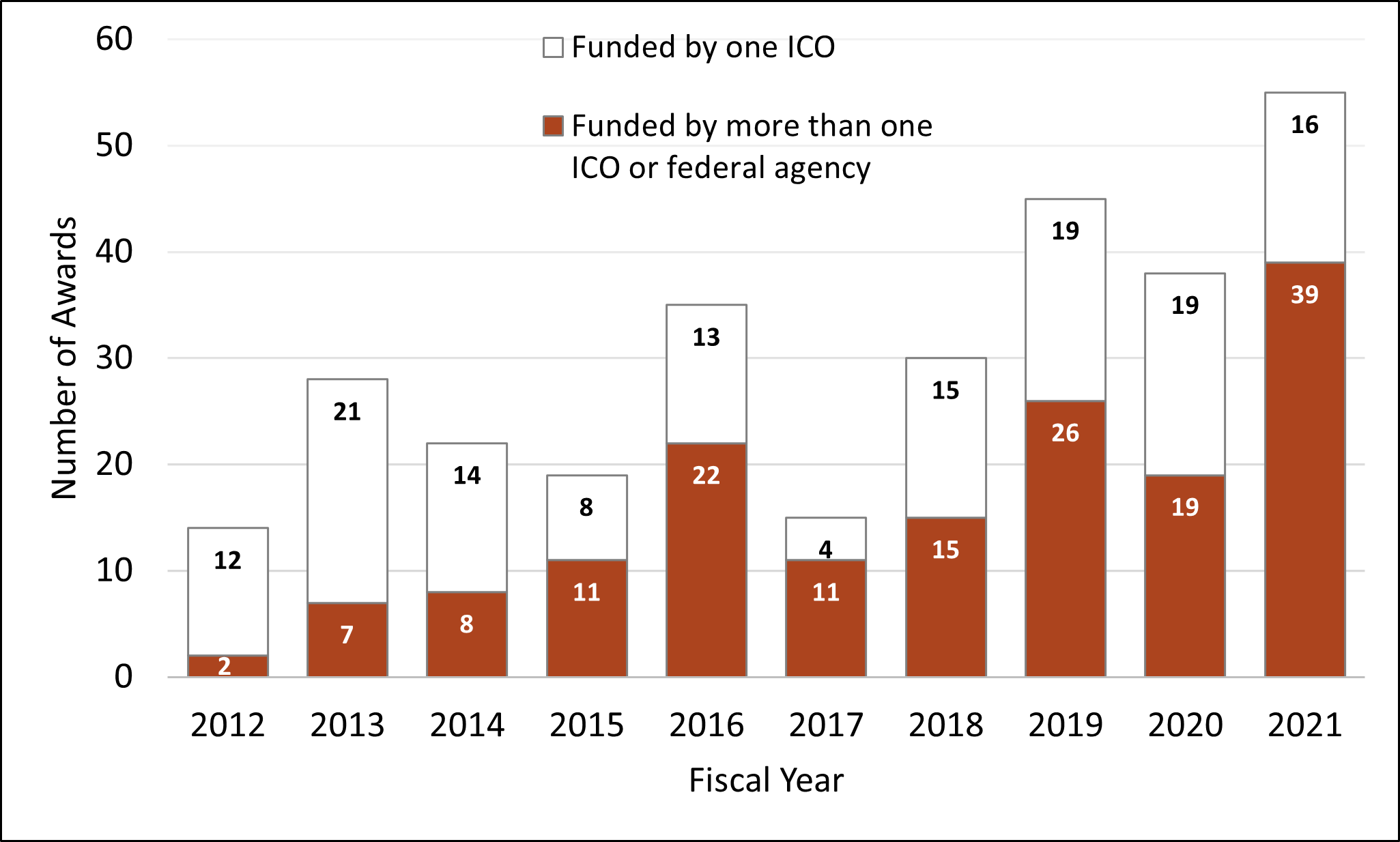A guest post from ODP staff members Liberty Walton, Elizabeth Neilson, Chino Amah-Mbah, Charlene Liggins, and Jacqueline Lloyd.
The ODP mission is to improve public health by increasing the scope, quality, dissemination, and impact of prevention research supported by NIH. One way we work toward this mission is by contributing funds to NIH Institutes, Centers, and Offices (ICOs) and federal agencies to help support prevention research activities that might not otherwise be funded. ODP co-funds many projects in response to ICO requests for prevention research activities that address evidence gaps, improve methodology, and train the next generation of investigators from diverse backgrounds.
Table 1. ODP Co-Funding Support Overview
| Who Can Request Support | What We Help Fund | Examples of Priority Areas |
|---|---|---|
|
|
|
ODP Co-Funding Support Has Grown Over Time
We recently analyzed ODP’s co-funded projects from Fiscal Years 2012–2021 (FY12–21) to identify trends and characterize projects. We examined project type, award amount, relevance to pressing issues in public health, and level of collaboration. Over this 10-year period, ODP funded 86% of the co-funding applications received from our federal partners, totaling $17,833,742 in award funding. Half of the 301 awards were for grants, while the remaining awards were for federal initiatives (26%) and for meetings, workshops, and conferences (24%).
Table 2. ODP Co-Funding Applications Received and Awarded FY12–21
| Project Type | Number of Total Applications | Number of Total Awards | Award Rate* | Total Award Funding |
|---|---|---|---|---|
| Grants | 194 (55%) | 151 (50%) | 78% | $10,417,592 (58%) |
| Federal initiatives | 83 (24%) | 79 (26%) | 95% | $5,976,715 (34%) |
| Meetings, workshops, and conferences | 75 (21%) | 71 (24%) | 95% | $1,439,436 (8%) |
| Total | 352 | 301 | 86% | $17,833,742 |
As our federal partners became more aware of ODP's co-funding resources, we received additional co-funding requests. ODP steadily increased the number of awards and amount of co-funding over time, growing from 14 awards totaling $335,000 in FY12 to 55 awards totaling $3,951,906 in FY21.
Figure 1. ODP Co-Funding Dollars and Awards FY12–21

ODP Co-Funds Projects That Focus on Pressing Public Health Issues
Co-Funded Projects
Explore all the research projects, meetings, and federal initiatives ODP has co-funded in past years.
ODP prioritizes projects that we think will have the most real-world impact such as those that address dissemination and implementation research, health disparities, social determinants of health, and leading risk factors for death in the United States as defined by the Global Burden of Disease. Our analysis showed 89% of ODP co-funded projects addressed at least one of these four priority areas and 47% addressed at least one of the top 12 risk factors for death.
Table 3. ODP Co-Funded Projects From FY12–21 by Category
| Project Category† | Number of Awards | Percent of Awards |
|---|---|---|
| Addressed at least one of ODP's priority areas | 267 | 89% |
| Dissemination and implementation research | 182 | 60% |
| Addressed at least one of the top 12 risk factors for death | 142 | 47% |
| Health disparities | 104 | 35% |
| Social determinants of health | 81 | 27% |
| Addressed multiple top 12 risk factors for death | 66 | 22% |
ODP Co-Funds Projects That Are Collaborative
Effective prevention research requires efforts involving multiple partners. When a project brings together different areas of expertise, it can lead to broader impacts. For that reason, ODP prioritizes collaborative research activities that involve more than one ICO or federal agency. Between FY12–21, ODP co-funding supported projects that contributed to an interdisciplinary environment for prevention research. We found the number of collaborative projects increased over the years, starting with two projects in FY12 and growing to 39 projects in FY21. In addition, starting in FY15, the majority of funded projects were collaborative projects, except for FY18 and FY20 when projects funded by one ICO and collaborative projects were funded at the same rate.
Figure 2. ODP Co-Funded Projects From FY12–21 by Collaboration Type

Future Directions
We were pleased to find that our co-funding portfolio supported prevention research at NIH in multiple ways. ODP increased the number of projects funded and amount of co-funding; we also funded projects that focused on pressing issues in public health and fostered collaboration. The results from this analysis will help inform and strengthen ODP’s partnerships across NIH and federal agencies to support investment in key research areas and address evidence gaps.
These findings enable data-driven decision-making on co-funding priorities to maintain a balanced portfolio that represents the spectrum of prevention research across NIH. We look forward to contributing more co-funding support to NIH ICOs and other federal partners to advance prevention research and improve public health.
If you have questions about our co-funding support, please email prevention@nih.gov.